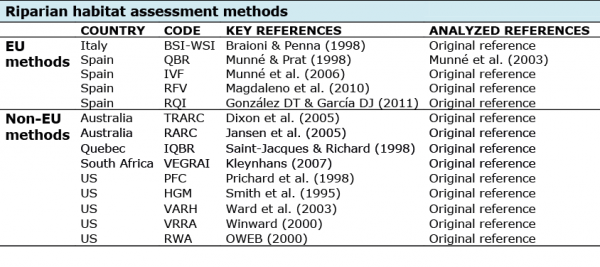Difference between revisions of "Riparian habitat assessment"
(→Other relevant information) |
(→Other relevant information) |
||
| Line 24: | Line 24: | ||
Table 1 lists key and analyzed references for methods of riparian habitat assessment. | Table 1 lists key and analyzed references for methods of riparian habitat assessment. | ||
| − | [[File:TableRef2.png|center|thumb| | + | [[File:TableRef2.png|center|thumb|600px| Table 1. Analyzed references for methods of riparian habitat assessment.]] |
[[Category:Tools]][[Category:Hydromorphological assessment methods]] | [[Category:Tools]][[Category:Hydromorphological assessment methods]] | ||
Revision as of 17:27, 8 February 2013
Riparian habitat assessment
Type
Hydromorphological assessment methods
Brief description
Riparian habitat assessment methods aim to identify, survey and assess riparian habitat conditions of rivers and streams. They are mainly applied at a local/reach scale, and generally to the overall river corridor, but focussing on vegetation characteristics. We reviewed 14 methods in total (5 for European countries and 9 for non-European countries).
Strengths, limitations and gaps
Methods of riparian habitat assessment adopt a similar approach to river habitat assessment, but focusing on the riparian component. They generally suffer the same limitations as for the habitat assessment (limited spatial and temporal scale, poor understanding of physical processes, etc.) but they successfully integrate vegetation in the assessment of river status. These methods have been developed mainly in southern European countries; they need validation and/or adaptation to be applied in other countries.
Other relevant information
Summary tables of analyzed physical habitat assessement methods are available here:
- For European countries: File:2 EU.pdf
- For non European countries: File:2 nonEU.pdf
In the table we recorded whether the analyzed method considers or not a specific feature. Three options were considered: presence (tick), absence ( ), and probably assessed (PA), the latter indicating when there is an uncertainty concerning whether the feature is collected and/or when the feature may be indirectly obtained.
Table 1 lists key and analyzed references for methods of riparian habitat assessment.
